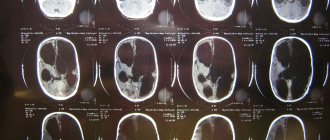Belyakova Alexandra Vladimirovna
Psychologist
Tikhomirova Evgenia Nikolaevna
Neurologist
Many parents face difficulties in raising teenagers, and in modern society this will not surprise anyone.
People around them try to explain withdrawal, aggression, and various deviant forms of behavior among young people as a result of adolescence and the desire to express themselves in this way. But the nature of this phenomenon is much deeper.
Causes
Factors that provoke inappropriate behavior in adolescents include:
- Hereditary predisposition - characteristics of the parents, as well as the impact of unfavorable environmental factors on the fetus (bad habits of the mother, working conditions, etc.).
- Social and economic – family instability, family conflicts, low social level of parents and low income.
- Unbearable loads - physical and psycho-emotional fatigue associated with large volumes of tasks at school or additional classes.
- Physiological characteristics - physical defects, flaws in appearance, defects in mental development, which lead to difficulties in adapting to a team, rejection among others, especially peers.
- Mental abnormalities - diseases, nervous and mental disorders, low threshold of excitability.
- Psychological impact - pressure and reproaches from parents, excessive severity or permissiveness, personal character traits (perfectionism or selfishness, indifference).
Diagnostics
Part of the assessment of adolescents at their health care visits should include an assessment of the risk or history of violent antisocial behavior or the risk of becoming a victim of such behavior. Answering questions about recent involvement in fighting, carrying or storing firearms in the home, and his or her sense of personal safety may reveal issues that require more in-depth assessment. Additional factors, such as physical or sexual abuse, problems at school, poor grades and attendance, history of trauma, and symptoms of mental health problems, indicate the need for evaluation by a psychiatrist. Traumatized and abused victims are not always willing to talk about the circumstances of the abuse for fear of retaliation or the involvement of the police. Treating the trauma and collecting forensic evidence of sexual abuse comes first, followed by a more comprehensive examination of the circumstances that led to the abuse.
The main manifestations of inappropriate teenage behavior
The behavior of a difficult teenager contradicts established social rules and norms.
Withdrawal into oneself, reluctance to make contact with others, excessive aggression in communication is what parents of teenagers most often have to deal with. And that's not the worst thing.
A manifestation of behavioral deviations can also be the desire to harm oneself (masochism, hoarding), while those around them do not suffer directly. In the case of antisocial and immoral behavior (alcoholism, drug addiction, prostitution), the harm done to one’s own body also affects the teenager’s loved ones, bringing them moral and sometimes physical suffering.
This type of deviant behavior, such as committing illegal acts (hooliganism, robbery, rape), poses a great threat to society, violating not only moral principles, but also legal norms.
Prevalence of antisocial behavior
In 1993-1994 The United States was ahead of the entire industrial world in teen antisocial behavior—the number of youth deaths from firearms, including suicide and manslaughter. From 1983 to 1993, the number of suicides involving firearms tripled, from 5 to 18:100,000. After 1993, the number of deaths and nonfatal injuries caused by firearms began to decline. Young people are more likely than girls to be victims of both fatal and non-fatal injuries; Women aged 15-24 are victims much more often than women of any other age.
According to the Youth Hazardous Behavior Surveillance System, in 1999, 17.3% of college students (26.6% of boys and 6% of girls) consistently carried a weapon (gun, knife, or bat) in the 30 days preceding the study. But compared to the 1991 study, gun ownership has declined. Nationally, 36.7% of students admitted to having been involved in a fight in the previous year. This figure also decreased from 137/100 students/12 months. in 1993 to 106/100 students/12 months. in 1999. The number of rapes and violence during an intended date remained at the same level (8.8% of students). Girls reported more incidents of both types of rape, with the exception of white boys and girls, who reported almost identical rates of dating violence (7.3% and 7.4%, respectively).
Teenagers are more likely than other age groups to become victims of violence. In 2000, the number of victims was 60.1:1000 among 12-15 year olds and 64.3:1000 among 16-19 year olds, which was almost 50% lower than in 1994. Although the thought of teenagers is rare comes to mind when one thinks of child abuse, yet adolescents account for nearly 25% of victims of child abuse and neglect. Adolescents and children under 5 years of age are the most likely victims of physical violence that results in injury.
Treatment and prevention
Attentive attitude towards a teenager on the part of parents and teachers can help to suspect deviations at an early stage and cope with them. In case of psychological disorders, diagnosis and treatment should be carried out by specialists.
It is important to clearly understand the cause and begin to correct it. At the same time, close cooperation on the part of the teenager, parents and teacher should bear fruit. During the conversation, the essence of the problem and the possible factors that provoked it are clarified. Psychological diagnostics based on passing tests also help.
Help for inappropriate behavior begins in the family with the right attitude. To avoid negativism and withdrawal, it is important to convince the teenager that there is a problem and stimulate the desire to overcome it. Pedagogical correction is carried out by searching for positive motivations, focusing on choosing a profession and forming life goals.
Clinical Brain Institute Rating: 2/5 — 2 votes
Share article on social networks
Social behavior of teenagers
⇐ PreviousPage 8 of 15Next ⇒
Sociological and psychological research in recent years has convincingly established serious deformations in the personal development and social behavior of growing Russian citizens. Of particular concern is not so much the progressive alienation and spiritual emptiness of children and adolescents, but their cynicism, cruelty, aggressiveness, hostility towards everything around them, including adults and peers, as well as the moral and ethical values, norms and rules of behavior officially accepted in society, spiritual standards and laws [7].
In its most painful form, this factor manifests itself during a turning point for the individual, during the child’s transition from childhood to adulthood.
The problem of adolescent aggressiveness affects society as a whole, it causes deep concern among teachers and parents, but the state proposes predominantly repressive sanctions to solve this problem. As a rule, these are measures of very sensitive influence on adolescents by law enforcement officers. In addition, a law was adopted according to which a Russian citizen bears criminal liability from the age of 14, or even 12 years. In other words, the credo of state policy in this social sphere boils down to the fact that the sooner a young person ends up “behind bars,” the better.
But not only parents and teachers are concerned about the problems of the younger generation; these questions are of keen scientific and practical interest to specialist researchers [24; 47; 84; 90; 124]. However, attempts to explain such a surge of aggressiveness in the modern youth environment, which has been observed in recent years, often turn out to be unsuccessful because not only in ordinary consciousness, but also in many theoretical concepts formulated by knowledgeable professionals, the phenomenon of aggression receives very contradictory interpretations, making it difficult to understanding and the possibility of phenomenological description.
Unfortunately, the problem of aggressiveness and cruelty at the present time not only has not lost its relevance, but has become one of the central ones in psychology and pedagogy. The need to determine the real psychological causes of a person’s aggressiveness, study the conditions and mechanisms of its formation, as well as means of prevention and correction determines the relevance of this problem [13; 18].
Since the beginning of the 60s, in many economically developed countries the number of pathological forms of behavior of minors has noticeably increased. There was a wave of teenage drug addiction, running away from home and vagrancy became a widespread phenomenon, and the problem of early alcoholism, suicidal behavior (auto-aggression), aggressiveness and cruelty became more acute [78].
The social importance of the problem under discussion is becoming obvious in our country. First of all, this is due to fundamental social changes and increasing instability in all spheres of life without exception. The difficult economic situation, the collapse of established worldviews, values and ideals, and the lack of necessary prerequisites for effective adaptation to new living conditions have led society to insurmountable difficulties and conflicts [63]. One of the most negative consequences of state policy in the social sphere is a serious deformation of intrafamily relations. Communication in the family becomes more and more formal and alienated and is practically reduced to the level of exclusively everyday issues. A clearly defined psychological distance usually arises between family members; each member is busy solving only his own problems and is not interested in the concerns and problems of other members. This inevitably leads to the loss of integrity, balance and harmony of relationships in such families. Parents, as a rule, are busy with issues of financial support for the family, are forced to work a lot, without receiving any spiritual satisfaction from their professional activities. This naturally leads to mental and physical overload and fatigue; a person simply does not have time for sincere and interested communication with loved ones. In such situations, emotional discomfort often arises, which very quickly develops into a state of neuropsychic tension and thereby contributes to the neuroticism of other family members, which, naturally, cannot but affect further family relationships. And, if such a vicious circle has formed in a family, it is almost impossible to break it. That is why, even according to official statistics, the number of divorces in Russia has long exceeded the number of marriages.
This situation in the family has a powerful negative impact on the formation of the psyche of a teenager, who finds himself alone with his many problems and difficulties that are generally characteristic of this age. The effect of these factors is manifested in increased negativism, in adolescents’ disdainful attitude towards any authorities, generally accepted norms and standards. It is expressed in defiantly demonstrative behavior towards adults, the manifestation of aggressiveness and cruelty in the most extreme forms, which increasingly brings young people to the dock [68].
The problem of adolescent aggressiveness in the psychological literature is clearly not sufficiently developed; there are few special studies devoted to these issues. The available data mainly concern the phenomenology of aggressiveness in general, but with regard to specific aspects of aggressive behavior in adolescence, there is only some fragmentary information obtained by researchers when studying the general problem of aggressiveness.
At the same time, from the point of view of preventing aggressive behavior and its terrible and sometimes irreparable consequences, it is extremely important to study the characteristics of this phenomenon in adolescents, to search for its underlying causes and socio-psychological prerequisites.
Adolescence in ontogenesis is an acute transition from childhood to adulthood; all the contradictions of the developing personality are most clearly expressed in it. On the one hand, this stage of development is characterized by negative trends in the behavior of a teenager; the disharmony of the developing personality, caused by a change in the system of needs, and the protest nature of behavior towards adults can be clearly expressed. On the other hand, adolescence is also distinguished by many positive factors - the child’s independence grows, his relationships with peers and parents become much more diverse and meaningful, his sphere of interests expands and qualitatively changes, a responsible attitude towards himself and others develops [21; 22; 75; 128; 129].
Meanwhile, in the scientific literature it has become a tradition to designate this age as “difficult”, “critical”, “conflict”, etc., and consider the aggressive behavior of adolescents in the context of the concept of “difficult teenager” [3]. But adolescence in itself is one of the most “difficult” periods of human life, so first of all it is necessary to find out what lies behind this definition, in relation to what or to whom a teenager turns out to be “difficult”.
Analysis of literary sources makes it possible to identify at least three essential signs of a “difficult” teenager [53; 54; 55; 98]:
1. The presence of forms of behavior in a teenager that deviate from generally accepted norms. The norm itself and the degree of deviation from it are most often determined using special diagnostic techniques, the results of which are interpreted by a specialist psychologist. In addition, specially organized systematic observation is used, which can be carried out not only by a psychologist, but by doctors, teachers and parents. To characterize deviant behavior, special terms are used - “deviance” and “delinquency”. Deviant (“deviate” - reject) is considered to be a type of behavior that goes beyond the scope of “normal” individual reactions, that is, deviations acceptable in a given culture. Delinquent behavior is one of the varieties of deviant behavior, which includes misdemeanors, minor offenses and offenses that are not subject to criminal punishment. Antisocial behavior includes criminal acts and actions.
2. A sign of a teenager’s “difficulty” is considered to be such behavioral disorders that are not easily corrected and corrected. In this regard, there is often a need to distinguish socially provoked forms of behavior from pathological ones associated with painful mental disorders.
3. “Difficult” are teenagers who, more than others, need an individual approach from teachers, educators, parents and peers.
Until now, many experts stubbornly defend the opinion that the causes of the teenage crisis are in the physiological changes that occur at this stage of development. As a rule, this age is associated with a pubertal crisis, where the process of puberty plays a major role. In the works of domestic psychologists [14; 102; 108] shows that puberty, like other changes associated with the development of the body, have a certain impact on the mental development of the child, but: firstly, this influence is mediated by the teenager’s attitude to the world around him, psychological comparison of himself with peers and adults; secondly, the determining factors in the development of a teenager’s personality are not the biological characteristics of the maturation of the body, but the child’s transition to a qualitatively new stage of social development, at which a conscious attitude towards oneself as a member of society is actually formed.
In this situation, alarming moments in the behavior of adolescents, such as aggressiveness, cruelty, hostility in the process of spontaneous group communication that develops in various kinds of companies, can take on a sustainable character. But this system of relationships, built, among other things, on the basis of strict and sometimes cruel laws of asocial teenage groups, is not a consequence of some genetic predisposition, initial teenage aggressiveness. Most often, it acts as a “replacement” activity, as a teenager’s reaction to the attitude of socially significant adults towards him. Most likely, this crisis can be considered as a situation of joint experience of this social conflict [32].
The need for spontaneous group communication is noted only by 14.5% of adolescents, but in reality such behavior was recorded in 56% of 11-17 year olds. According to D.I. Feldshtein [107], this circumstance is due to the fact that if a teenager’s need for intimate and personal communication is mostly satisfied, then his tendency towards socially oriented forms of behavior remains unsatisfied in 38.5% of cases, thereby giving rise to the phenomenon of spontaneous group communication .
A person is not born an egoist or an altruist, modest or boastful, an atheist or a believer; that's what he becomes. Therefore, only in the process of human development as an individual do both socially useful and socially harmful traits arise. DI. Feldstein studied juvenile delinquents - physically and mentally healthy children - and convincingly proved this fact.
It turned out that the core of the conflict that led to the moral deformation of the personality of these adolescents was not biological, genetically programmed qualities, but the shortcomings of family and school education. These teenagers, in particular, had lost interest in school and had virtually no connections to school. As a result, they are usually 2-4 years behind their peers in terms of their educational level [102]. It turned out that this lag, as well as the deformation of the cognitive, emotional, value-need and volitional spheres of the personality, are not determined by the mental development of these children. They have normal mental capabilities, and their targeted inclusion in a system of multifaceted educational and social activities ensures the successful elimination of intellectual neglect and passivity.
Unfortunately, the demands put forward by adults, characteristic of the current educational system in society, do not take into account the peculiarities of the formation of a teenager’s personality, which inevitably leads to a “conflict of generations”, therefore the teenager naturally develops the need for independence, self-realization, and a desire to get rid of excessive guardianship appears. . Critically thinking about himself and those around him, the teenager protests against the hypocrisy of adults, their imaginary righteousness, and, often, the deceit of their actions.
A teenager wants not only attention, but also understanding and trust from adults. He strives to play a certain social role not only among his peers, but also among older people. In the adult community, a position has been established that impedes the development of a teenager’s social activity - he is a child and must “obey his elders.” As a result, a psychological barrier arises between adults and adolescents, and in an effort to overcome it, many adolescents resort to aggressive forms of behavior.
The most complete picture of the essence of aggressive behavior in adolescents is provided by an analysis of its motivation. To a large extent, it is associated with negative emotions: anger, fear, revenge, hostility. The aggressive behavior of adolescent children, mediated by these emotions, is expressed in insults and fights, often ending in bodily harm, rape, murder, damage or destruction of property.
It is this behavior that is often considered as the most convincing model confirming the thesis about the genetic nature of aggressiveness [161]. At the same time, it is believed that aggressive, especially “insufficiently motivated” behavior is a direct manifestation of an individual’s genetic disadvantage, even if not expressed in some kind of chromosomal anomaly.
At the same time, the question of the genesis of aggressiveness, the role that biological and social factors play in its origin, is extremely complex. There are theories according to which aggressiveness is a trait inherent in humans by nature, the same as instinct or need. First of all, this is a theory developed by S. Freud [113], who associated aggression with an innate desire for death, as powerful as libido - the desire for life. In his opinion, the death drive prompts a person to self-destruction, and aggression becomes a mechanism through which this drive - destruction - is directed towards other objects, primarily other people.
It should be noted that the theory of the innateness of aggression was defended not only by psychoanalysts, but also by psychologists who did not share the conceptual positions of S. Freud. Thus, V. McDougall [163], who did not accept the psychoanalytic doctrine, at the same time recognized the “instinct of pugnacity” inherent in man by nature. G. Murray [165] included among the primary human needs the need for aggression, which encourages organisms to look for an opportunity to attack in order to cause some damage to the enemy.
According to K. Lorenz [57], man, as one of many species of the animal world, has an instinct of aggression. As an example, he cites the case of a teenager who, when he first met a peer, immediately began to fight with him, acting in exactly the same way as monkeys, rats and lizards behave in similar cases.
E. Fromm [117] analyzed in detail the problem of human destructiveness, trying to answer the question of whether a person’s tendency to destruction is innate, instinctual, or whether it is due to social reasons. He also classified aggressiveness as a “destructive need.” At the same time, he considered instinctoid personality traits that cannot be reduced to instincts, but have a certain natural basis. What deserves the most attention is E. Fromm’s consideration [117] of data from zoopsychology, child psychology and anthropology, which led him to the general conclusion that the theory of predetermination of human destructiveness, and therefore aggressiveness, by natural instincts is unfounded. Having made a concession to the biologizing interpretation of aggressiveness, E. Fromm nevertheless came to the conclusion that it is not instinctive, but instinctoid, that is, only similar to instinct.
Currently, the assertion about the aggressive nature of man and the genetic determination of aggression finds even more opponents.
Anthropological studies clearly demonstrate that certain manifestations of aggressiveness are closely related not only to biological determinants, but also to types of human culture. Experiences and emotions generated by both external and internal causes are usually expressed in a person in the form accepted in the culture to which he belongs, that is, the formation of aggressive behavior and the development of aggressiveness largely depends on social conditions that are determined by macro- and microsocial factors, such as the state, the immediate social environment, a small group. Aggression in open or disguised form is often cultivated in society as a weapon in the struggle for power. The manifestation of aggressiveness is facilitated by shortcomings in education carried out by various social institutions - not only family and school, but also the media.
Many studies have been devoted to elucidating the influence of parenting style in the family and school on the aggressiveness of children. A. Bandura and R. Walters [11], based on surveys and their own life observations, found that if mothers are lenient towards the aggressiveness of their children and even tend to indulge them, then the children become even more aggressive in their actions. However, in another study they showed that children who are subjected to very strict punishments also behave very aggressively, especially towards their peers. Moreover, physical punishment for aggressive behavior only increases the cruelty of children.
An aggressive teenager is most often an ordinary child who is characterized by normal heredity. And he acquires aggressive traits under the influence of mistakes, shortcomings, omissions in educational work, and difficulties arising in his environment. Aggression as a personal characteristic is formed in a teenager mainly as a form of protest against the misunderstanding of adults, due to dissatisfaction with his position in society, which is manifested in corresponding behavior.
At the same time, the development of a teenager’s aggressiveness can also be influenced by the natural characteristics of his temperament, such as excitability and the strength of emotional response, which contribute to the formation of certain character traits – hot temper, irritability, and inability to restrain oneself [94]. Naturally, in a state of frustration, a teenager with such a mental organization seeks a way out of the created internal tension, including in a fight, swearing and other socially unapproved forms of behavior. In addition, aggression can be caused by the need for self-defense or to satisfy the growing body's need for natural activity, when the teenager does not find any other way for this than a fight or, at least, verbal threats. And for some teenagers, participation in fights is a kind of assertion of oneself in the eyes of others, when, through the demonstration of physical aggression, a certain line of behavior is developed that reflects the norms accepted in asocial groups.
Thus, in adolescence, due to the complexity and inconsistency of the process of personality formation, internal and external conditions of its development, situations may arise that disrupt the normal course of personal development, creating objective prerequisites for the emergence and manifestation of aggressiveness.
⇐ Previous8Next ⇒
Recommended pages:
Use the site search:
Health care
In the case of acute injury due to violent abuse, the treatment plan must meet the standards established by the AAP protocol. This protocol includes stabilization, assessment and treatment of trauma, assessment of the circumstances of the abuse, psychological assessment of the victim, recovery, and monitoring of behavioral and psychological consequences after the victim is discharged from the hospital. Details of the required evaluation and documentation for victims of sexual abuse are provided in the American College of Emergency Physicians textbook, Assessing and Treating Victims of Sexual Abuse or Sexual Assault. Key elements of these recommendations include forensic evidence, STD treatment, and pregnancy prevention. Preventive treatment for chlamydia and gonorrhea and contraception after sexual intercourse are especially recommended.











